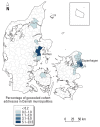Arsenic in drinking-water and risk for cancer in Denmark
- PMID: 18288323
- PMCID: PMC2235208
- DOI: 10.1289/ehp.10623
Arsenic in drinking-water and risk for cancer in Denmark
Abstract
Background: Arsenic is a well-known carcinogen, which is often found in drinking-water. Epidemiologic studies have shown increased cancer risks among individuals exposed to high concentrations of arsenic in drinking-water, whereas studies of the carcinogenic effect of low doses have had inconsistent results.
Objective: Our aim was to determine if exposure to low levels of arsenic in drinking-water in Denmark is associated with an increased risk for cancer.
Methods: The study was based on a prospective Danish cohort of 57,053 persons in the Copenhagen and Aarhus areas. Cancer cases were identified in the Danish Cancer Registry, and the Danish civil registration system was used to trace and geocode residential addresses of the cohort members. We used a geographic information system to link addresses with water supply areas, then estimated individual exposure to arsenic using residential addresses back to 1970. Average exposure for the cohort ranged between 0.05 and 25.3 microg/L (mean = 1.2 microg/L). Cox's regression models were used to analyze possible relationships between arsenic and cancer.
Results: We found no significant association between exposure to arsenic and risk for cancers of the lung, bladder, liver, kidney, prostate, or colorectum, or melanoma skin cancer; however, the risk for non-melanoma skin cancer decreased with increasing exposure (incidence rate ratio = 0.88/microg/L average exposure; 95% confidence interval, 0.84-0.94). Results adjusted for enrollment area showed no association with non-melanoma skin cancer.
Conclusions: The results indicate that exposure to low doses of arsenic might be associated with a reduced risk for skin cancer.
Keywords: arsenic; cancer; cohort study; drinking-water; geographic information system.
Figures




Similar articles
-
Long-term exposure to low-level arsenic in drinking water and diabetes incidence: a prospective study of the diet, cancer and health cohort.Environ Health Perspect. 2014 Oct;122(10):1059-65. doi: 10.1289/ehp.1408198. Epub 2014 Jun 13. Environ Health Perspect. 2014. PMID: 24927198 Free PMC article.
-
Low-level arsenic in drinking water and risk of incident myocardial infarction: A cohort study.Environ Res. 2017 Apr;154:318-324. doi: 10.1016/j.envres.2017.01.028. Epub 2017 Jan 31. Environ Res. 2017. PMID: 28157645
-
Low-level exposure to arsenic in drinking water and incidence rate of stroke: A cohort study in Denmark.Environ Int. 2018 Nov;120:72-80. doi: 10.1016/j.envint.2018.07.040. Epub 2018 Jul 31. Environ Int. 2018. PMID: 30071456
-
Arsenic, internal cancers, and issues in inference from studies of low-level exposures in human populations.Toxicol Appl Pharmacol. 2007 Aug 1;222(3):252-7. doi: 10.1016/j.taap.2007.01.026. Epub 2007 Feb 24. Toxicol Appl Pharmacol. 2007. PMID: 17382983 Free PMC article. Review.
-
Arsenic exposure and bladder cancer: quantitative assessment of studies in human populations to detect risks at low doses.Toxicology. 2014 Mar 20;317:17-30. doi: 10.1016/j.tox.2014.01.004. Epub 2014 Jan 21. Toxicology. 2014. PMID: 24462659 Review.
Cited by
-
Zinc Essentiality, Toxicity, and Its Bacterial Bioremediation: A Comprehensive Insight.Front Microbiol. 2022 May 31;13:900740. doi: 10.3389/fmicb.2022.900740. eCollection 2022. Front Microbiol. 2022. PMID: 35711754 Free PMC article. Review.
-
A Systematic Review and Meta-Regression Analysis of Lung Cancer Risk and Inorganic Arsenic in Drinking Water.Int J Environ Res Public Health. 2015 Dec 7;12(12):15498-515. doi: 10.3390/ijerph121214990. Int J Environ Res Public Health. 2015. PMID: 26690190 Free PMC article.
-
Arsenic exposure and cancer mortality in a US-based prospective cohort: the strong heart study.Cancer Epidemiol Biomarkers Prev. 2013 Nov;22(11):1944-53. doi: 10.1158/1055-9965.EPI-13-0234-T. Epub 2013 Oct 17. Cancer Epidemiol Biomarkers Prev. 2013. PMID: 23800676 Free PMC article.
-
Arsenic in Drinking Water and Mortality for Cancer and Chronic Diseases in Central Italy, 1990-2010.PLoS One. 2015 Sep 18;10(9):e0138182. doi: 10.1371/journal.pone.0138182. eCollection 2015. PLoS One. 2015. PMID: 26383851 Free PMC article.
-
Arsenic Exposure and Breast Cancer Risk: A Re-Evaluation of the Literature.Nutrients. 2020 Oct 28;12(11):3305. doi: 10.3390/nu12113305. Nutrients. 2020. PMID: 33126678 Free PMC article. Review.
References
-
- Abernathy CO, Chappell WR, Meek ME, Gibb H, Guo HR. Is ingested inorganic arsenic a “threshold” carcinogen? Fundam Appl Toxicol. 1996;29:168–175. - PubMed
-
- Abernathy CO, Thomas DJ, Calderon RL. Health effects and risk assessment of arsenic. J Nutr. 2003;133:1536S–1538S. - PubMed
-
- Agency for Toxic Substances and Disease Registry. Toxicological Profile for Arsenic (Draft for Public Comment) GA: U.S. Department of Health and Human Services; 2005.
-
- Bates MN, Rey OA, Biggs ML, Hopenhayn C, Moore LE, Kalman D, et al. Case-control study of bladder cancer and exposure to arsenic in Argentina. Am J Epidemiol. 2004;159:381–389. - PubMed
-
- Bates MN, Smith AH, Cantor KP. Case-control study of bladder cancer and arsenic in drinking water. Am J Epidemiol. 1995;141:523–530. - PubMed
Publication types
MeSH terms
Substances
LinkOut - more resources
Full Text Sources
Medical

